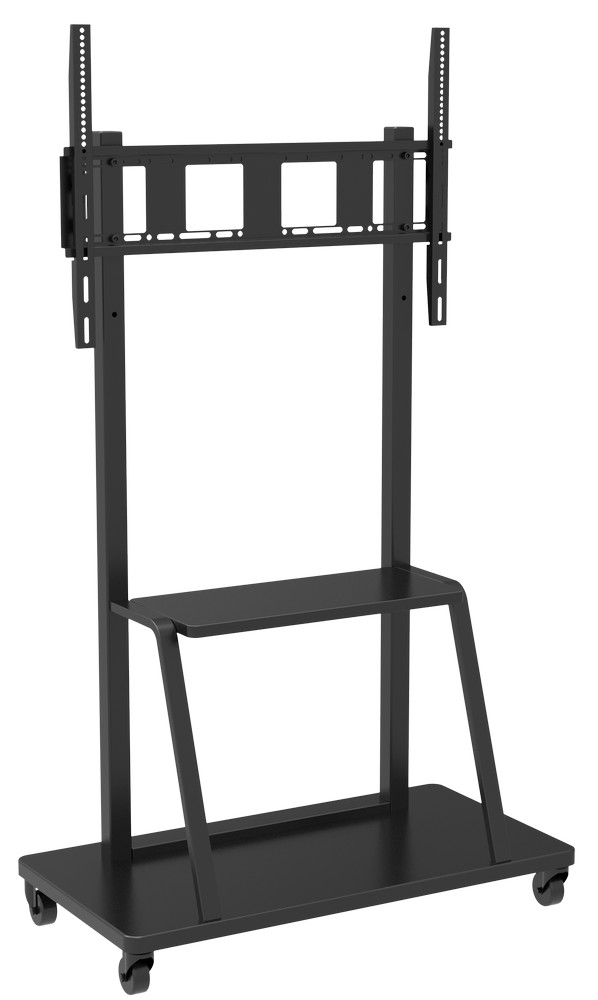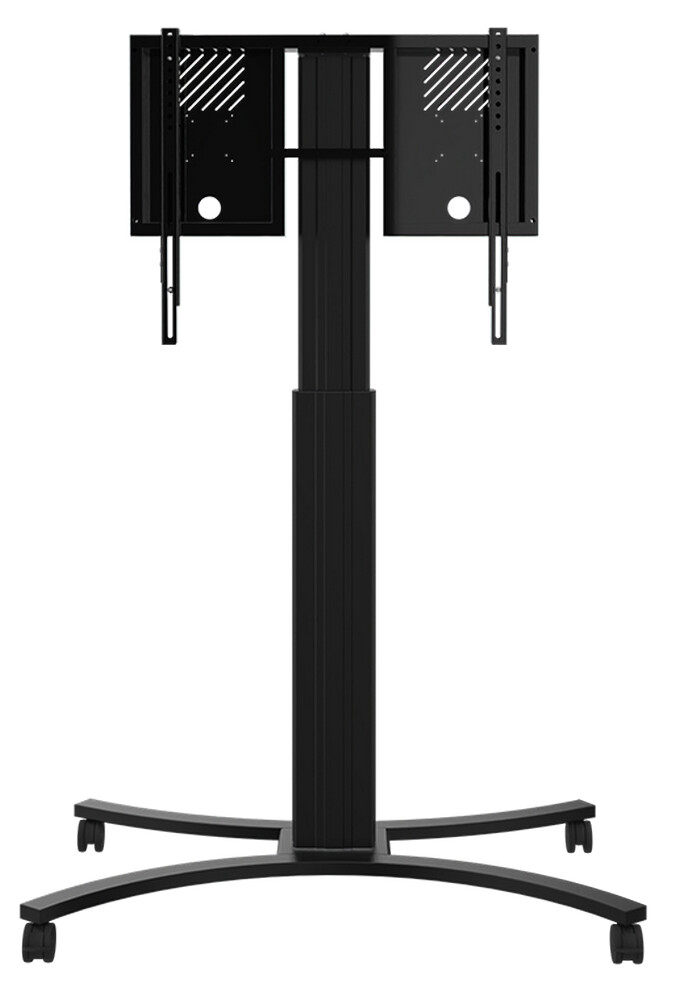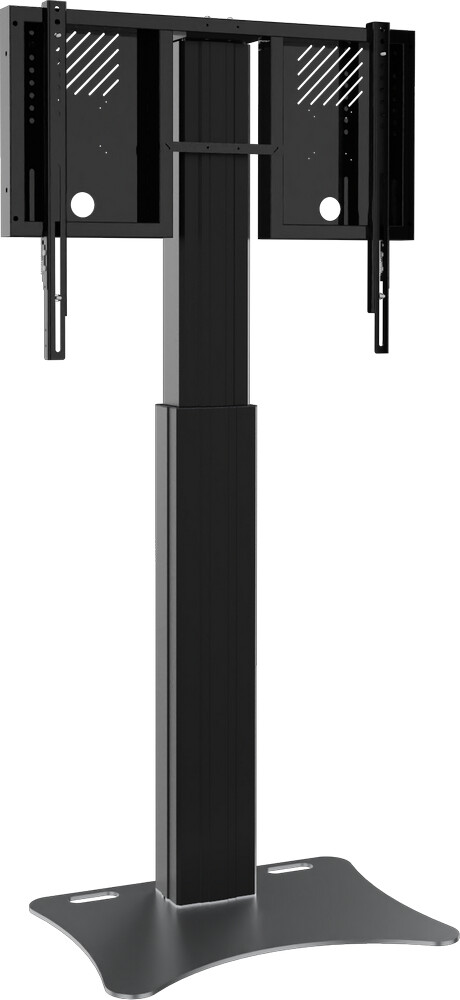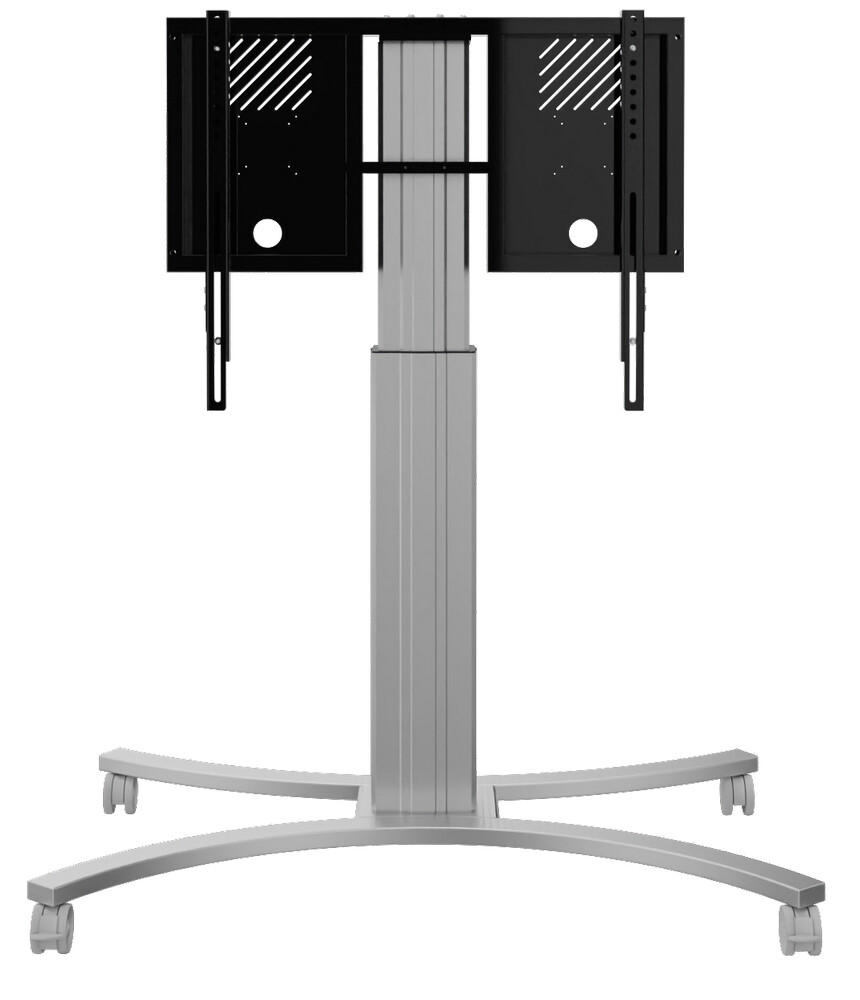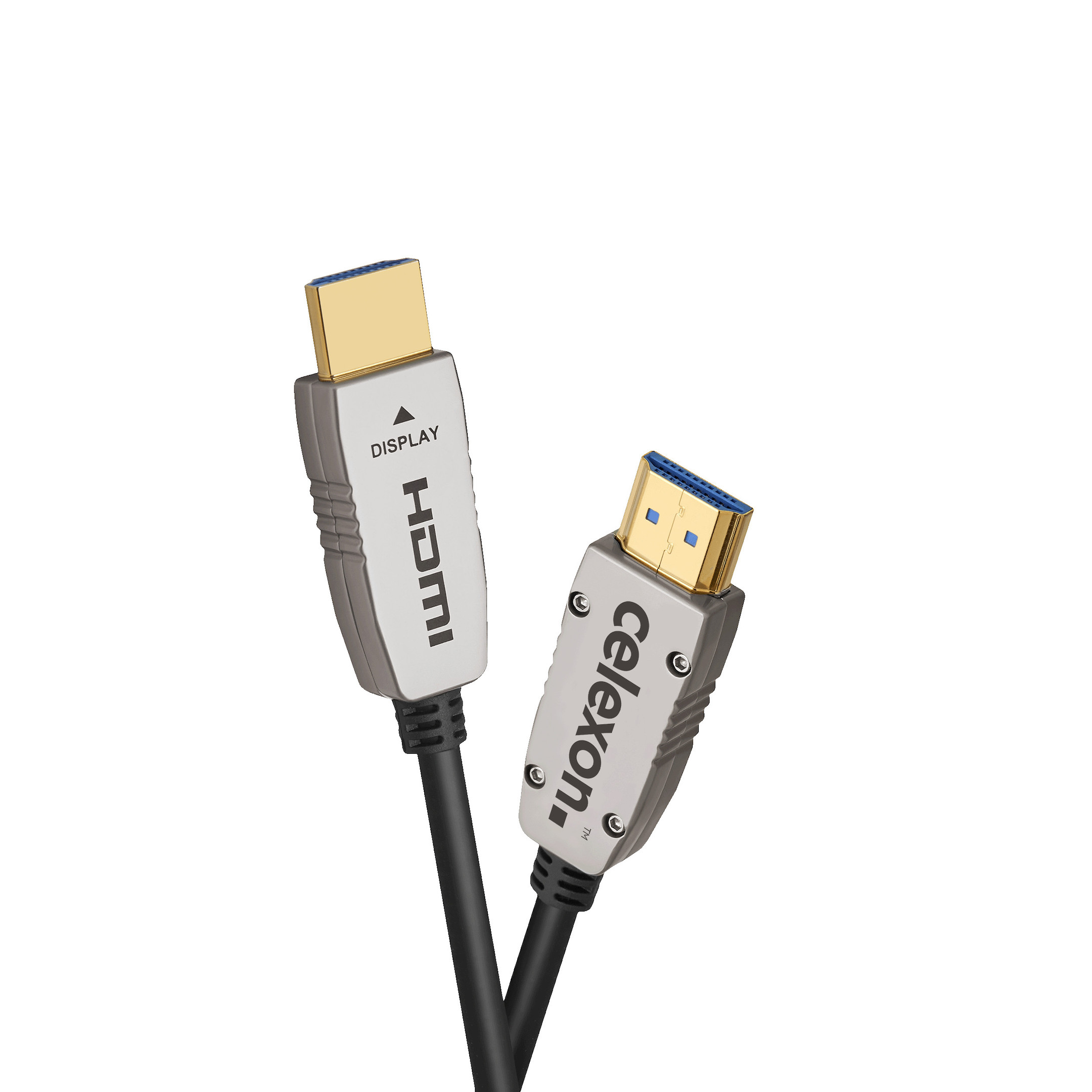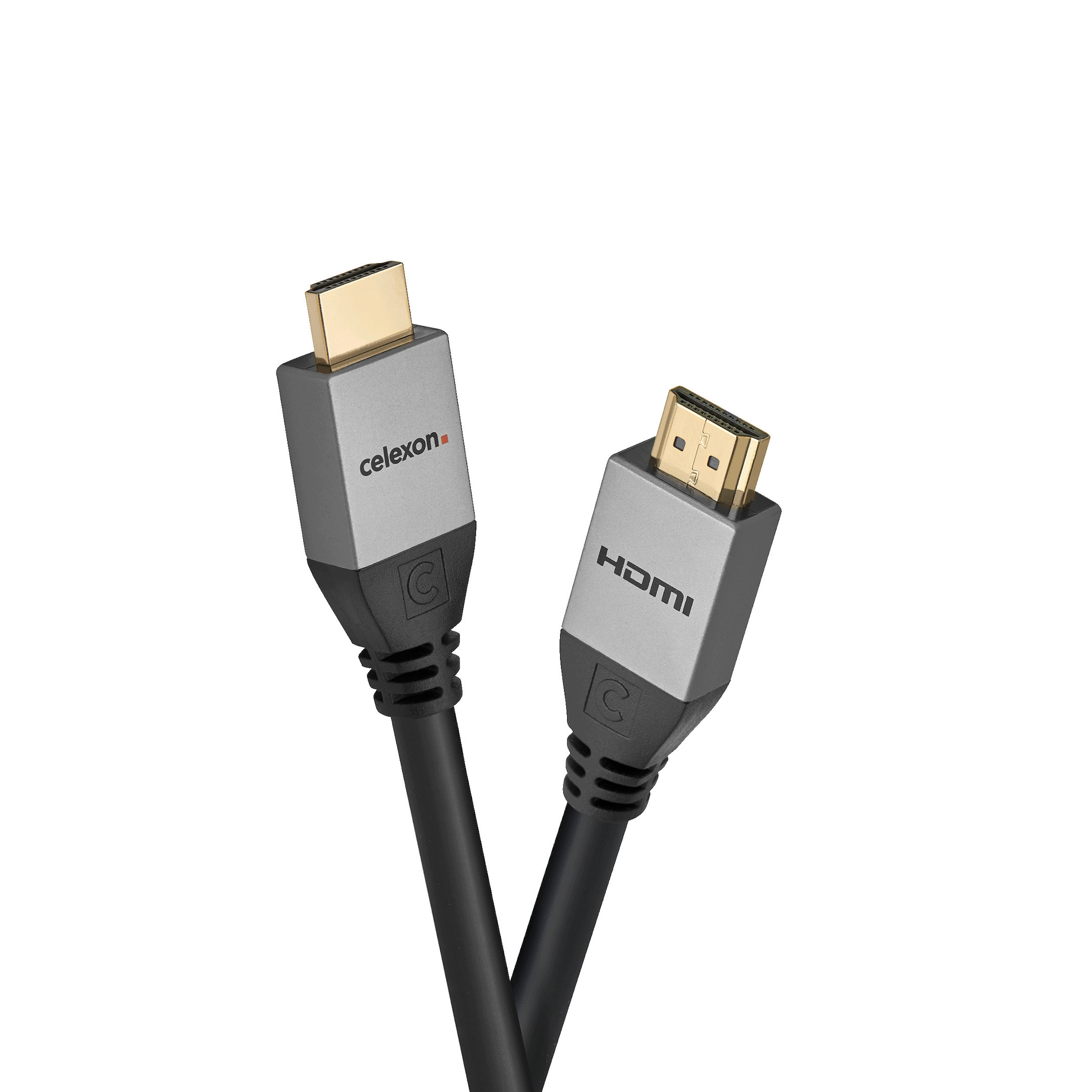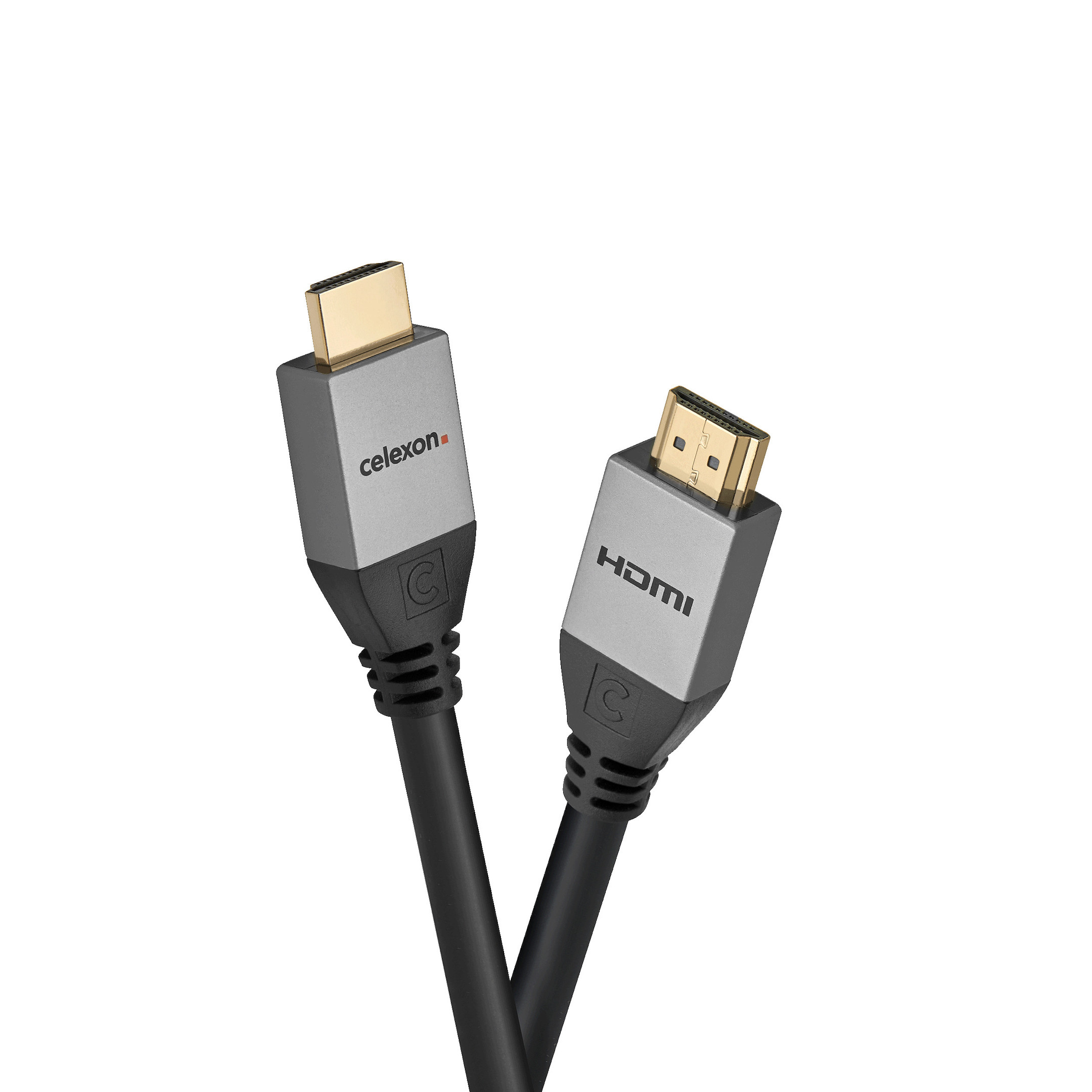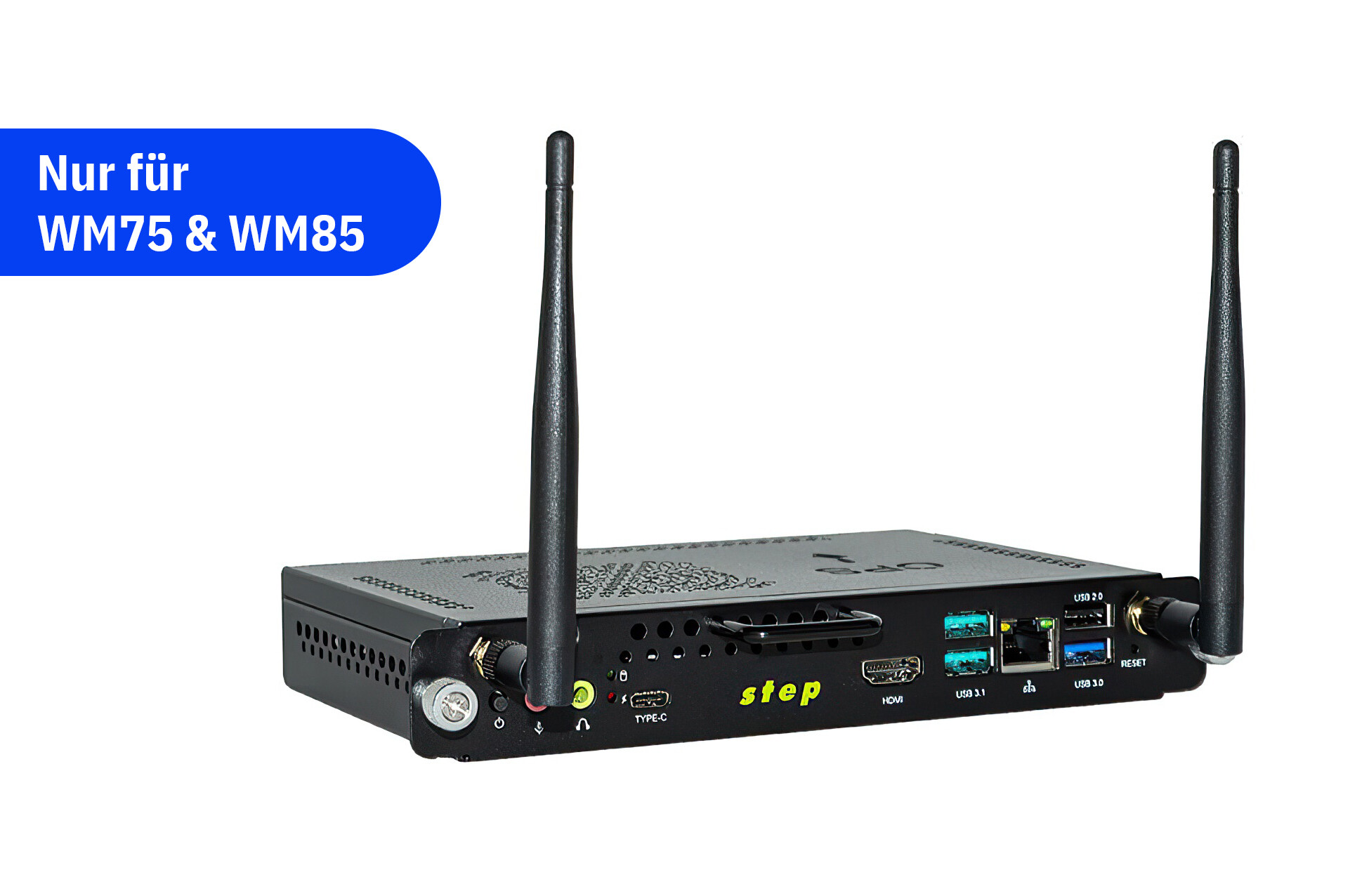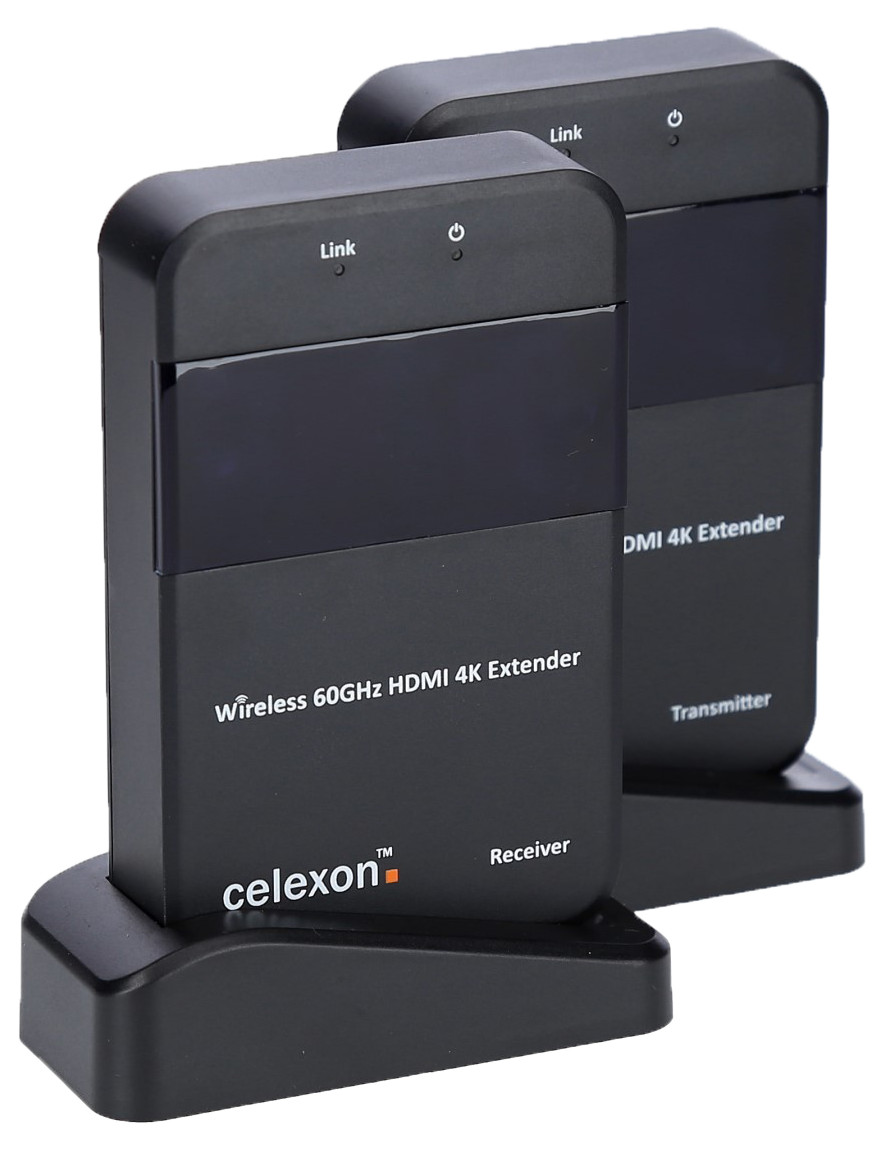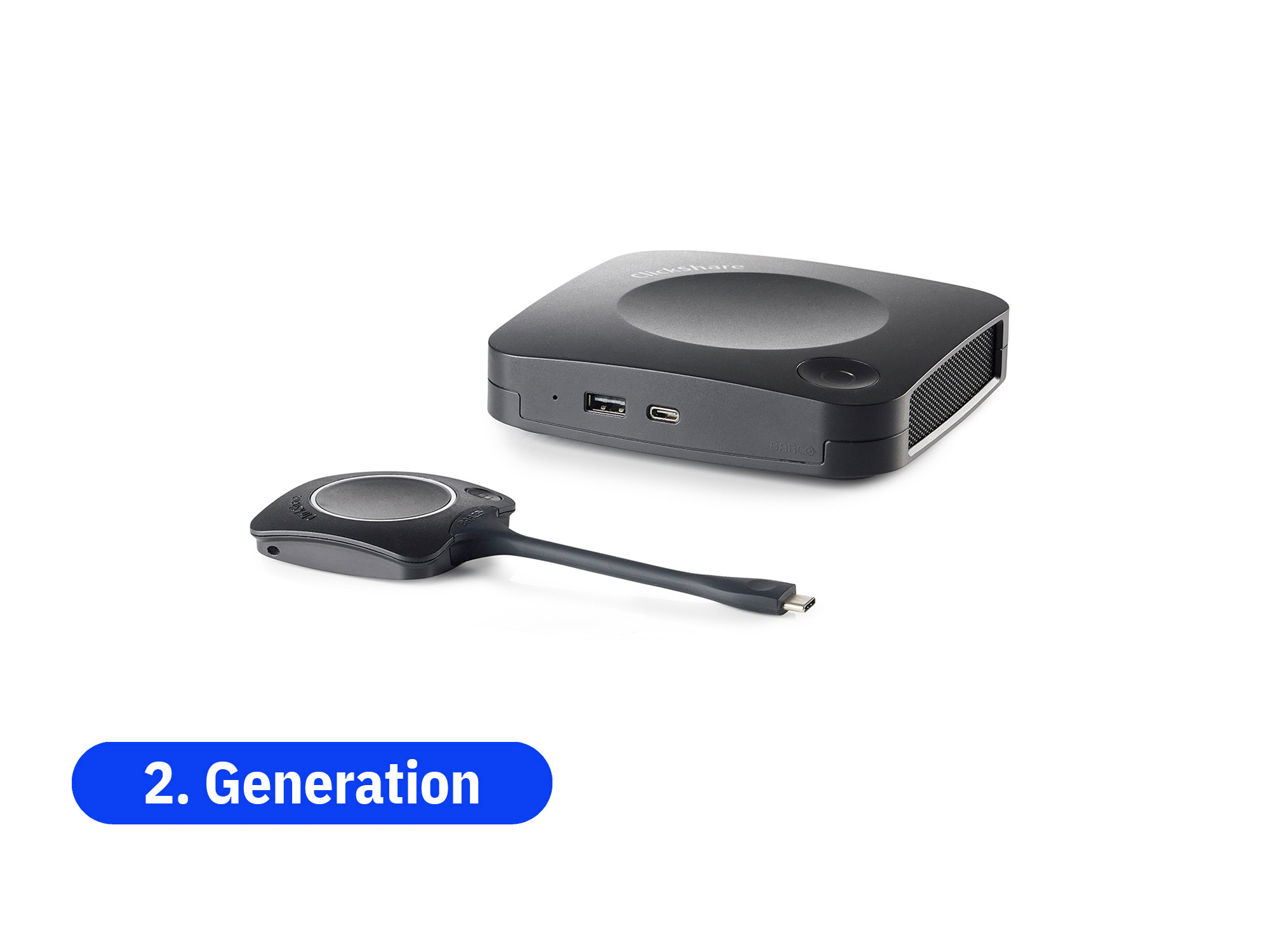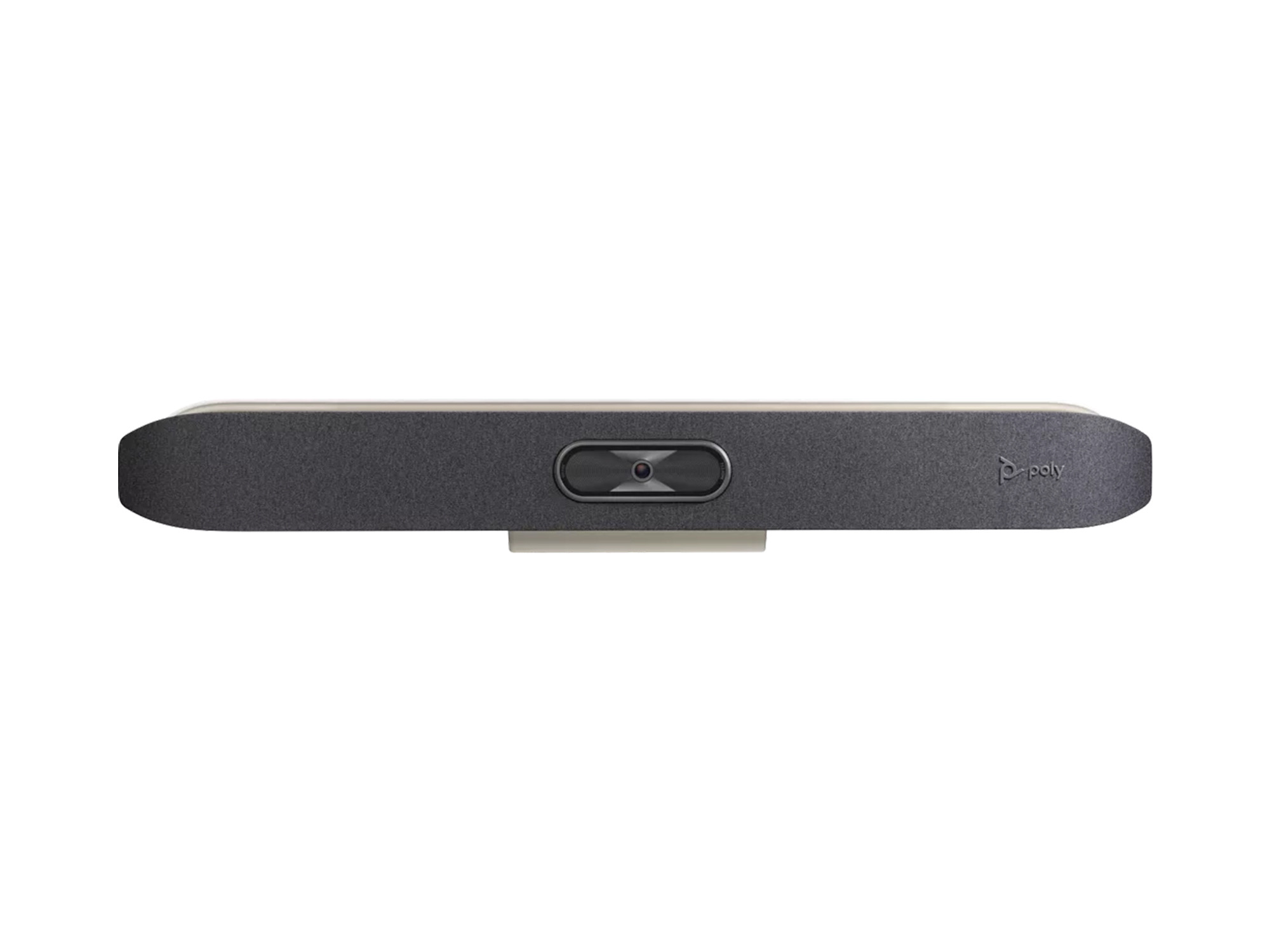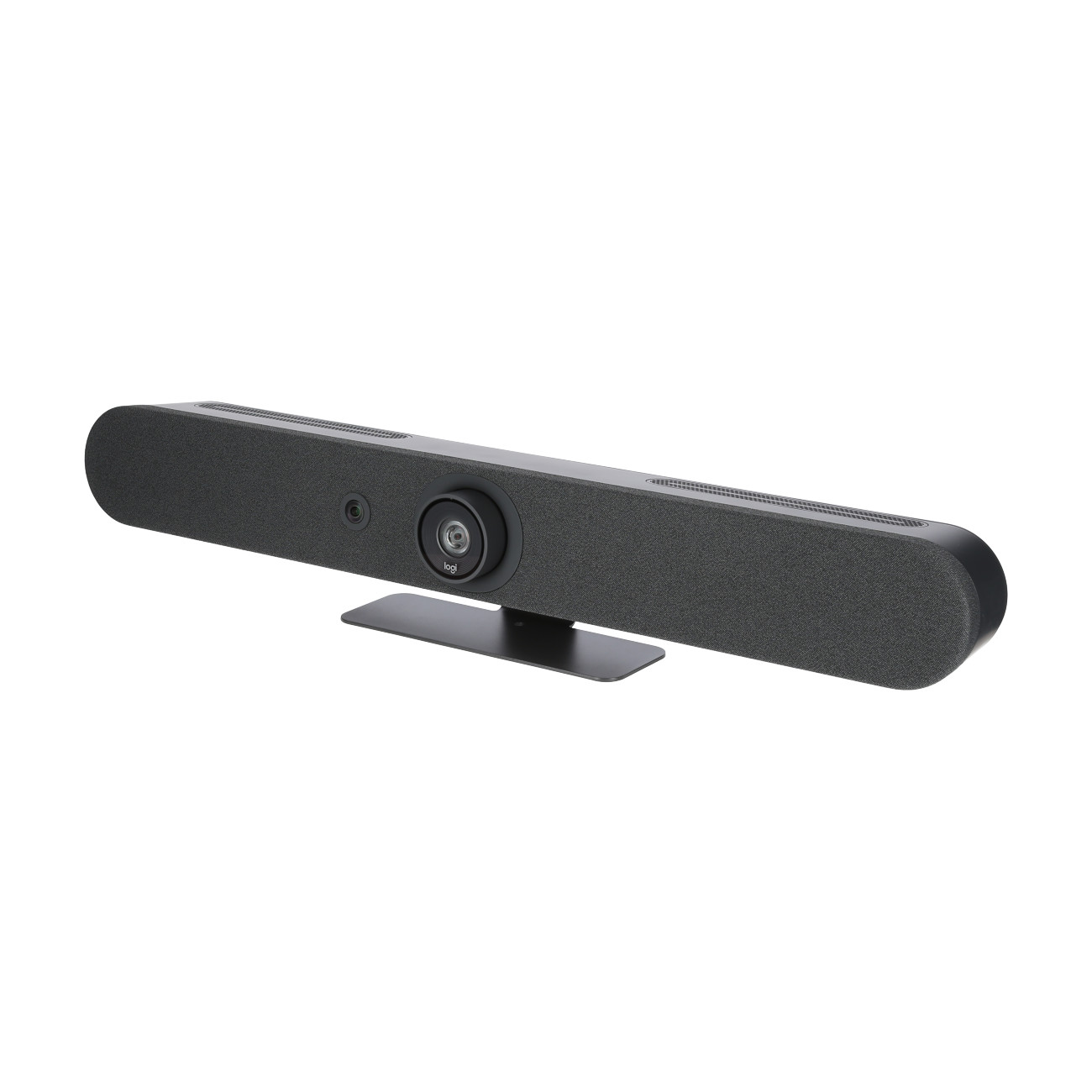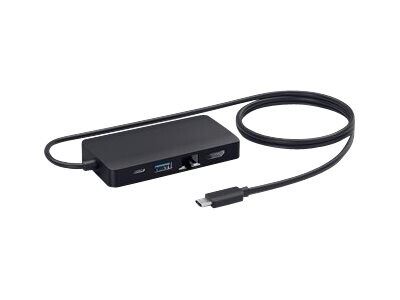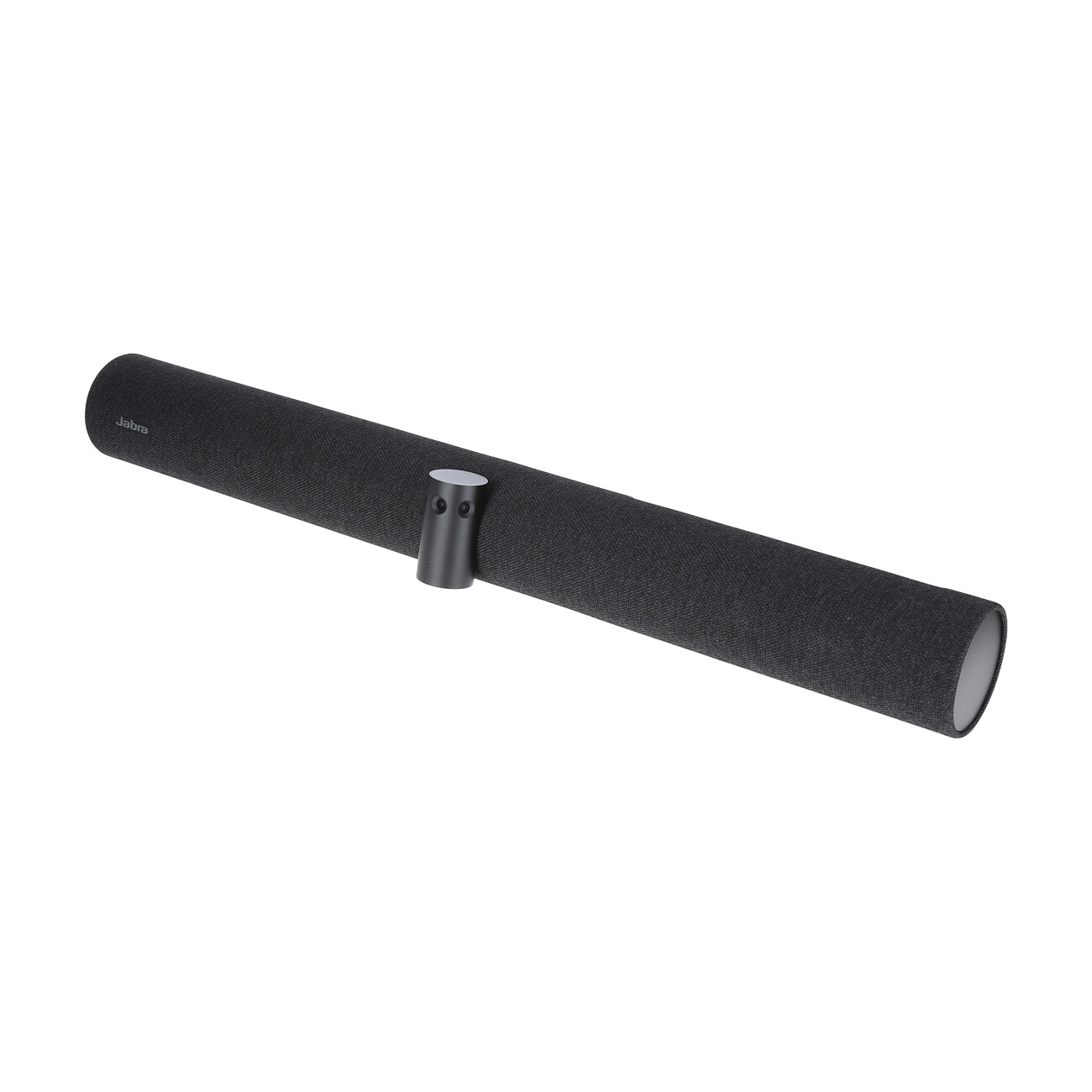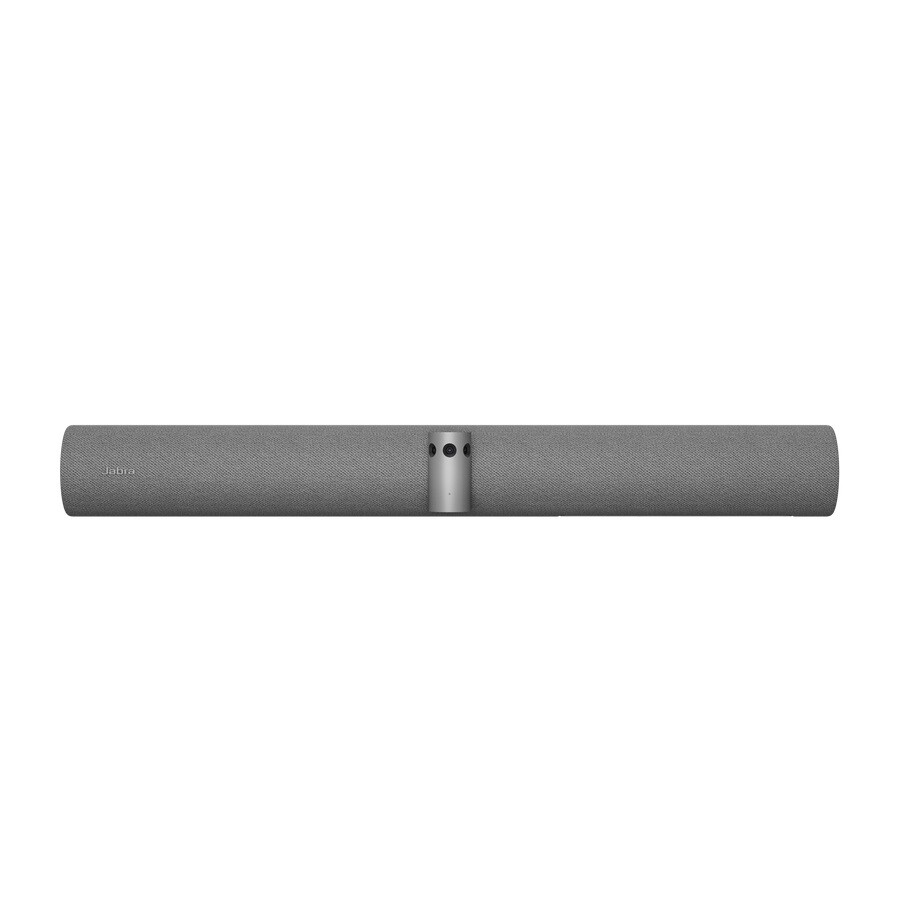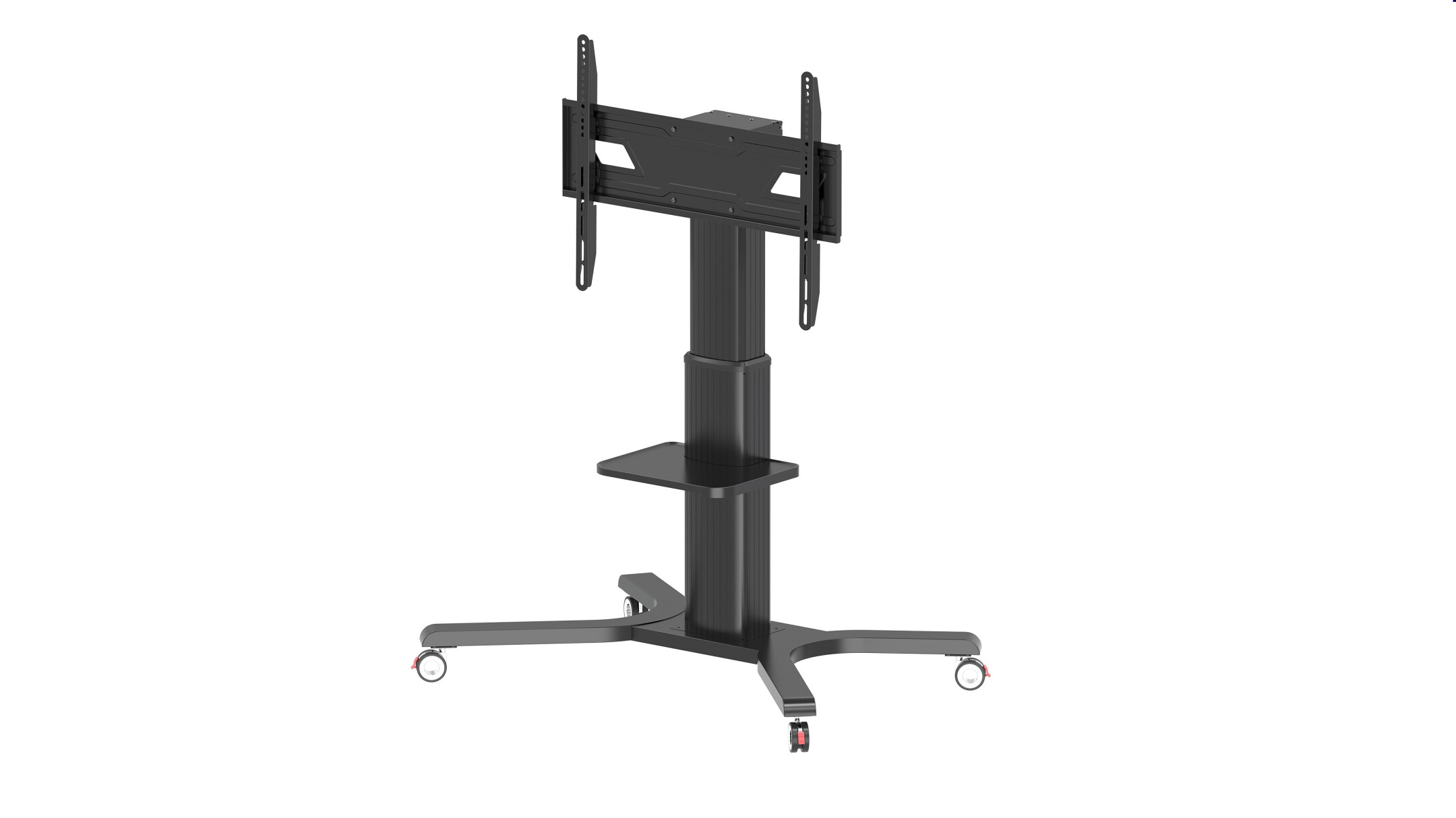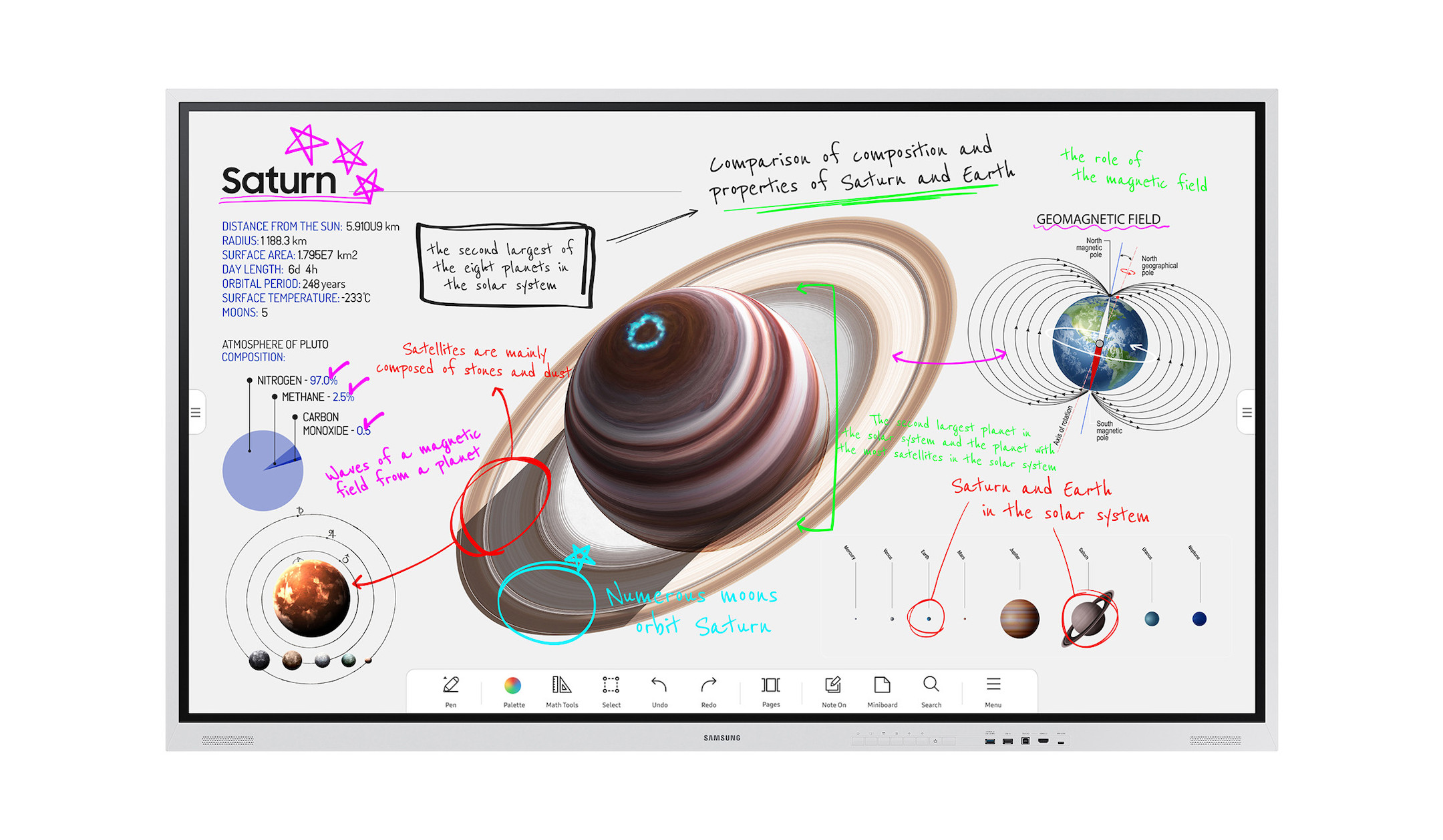































£1,449.00*
- Resolution 3840 x 2160 4K UHD
- panel technology VA
- Aspect Ratio 16:9
- Max. Brightness 350 cd/m²


Frequently purchased together
Product information
Samsung Flip Pro WM75B
A new, advanced level of learning for the future of education
- Drawing experience with 2.048 pressure points and the industry's best latency of only 26 ms
- A realistic writing experience with pen and brush modes, quick tool and palette
- Various connectivity options such as USB, HDMI, DP and OPS slot as well as easy screen sharing via wireless
- Various learning experience with boxlight or video call applications
Unlimited learning possibilities.
As the digitisation of education accelerates to enable high-impact, interactive collaboration, Flip Pro gives educators the tools they need to deliver a new, advanced level of learning. With versatile connectivity, smart software and intuitive features, Flip Pro ushers in the future of education.
Better interaction with premium multi-touch
Fast and multi-touch
Flip Pro features the industry's shortest latency of only 26 ms and predictive logic that ensures a realistic, fluid drawing experience with 2,048 pressure points built directly into the display to enhance creativity. In addition, Flip Pro enables multi-touch for up to 20 people for enhanced interactivity.
Bring ideas to life in an instant
Intuitive writing and drawing
With Pen and Brush mode, ideas instantly come to life on Flip Pro, providing a realistic writing experience while flexible erasing requires only a finger or palm movement. The quick tool and palette menu keeps creativity flowing, and the shift key easily activates a new note-taking layer interface.
Stay connected from any source
Multi-faceted connectivity
Flip Pro offers multiple connectivity options, including USB, HDMI, DP and OPS slot. Educators can connect any device to access content and display information on a larger screen. They can also connect to a network and other devices via the LAN port and wireless screen mirroring.

One port for three functions
3-in-1 USB-C port
Connectivity is enhanced with 3-in-1 USB-C connectivity that enables screen mirroring, touch control and charging of external devices (max. 65 W). Educators can easily connect the device to the USB Type-C port to create interactive and engaging lessons without hassle.
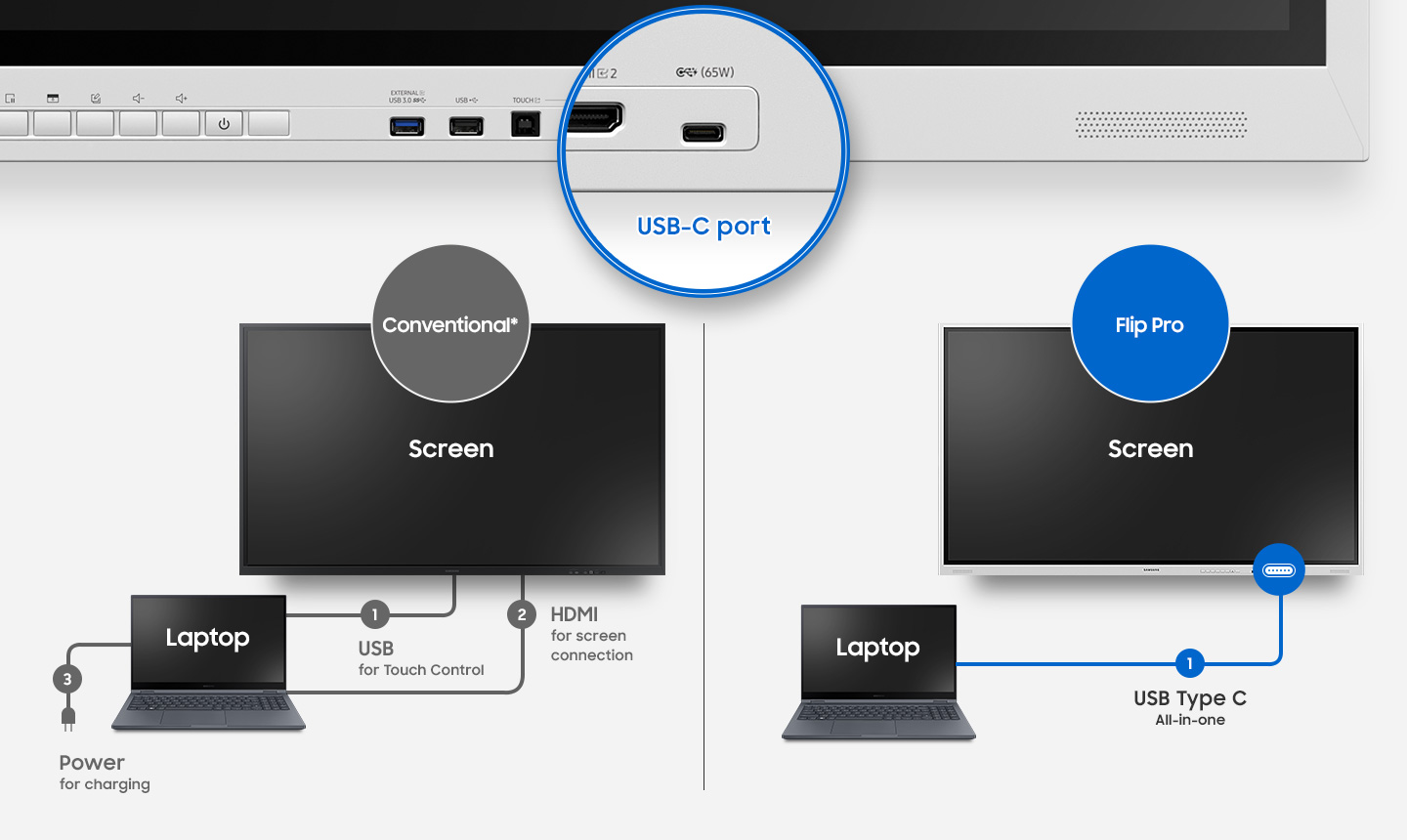
Sharing with AirPlay 2
AirPlay2
The Flip Pro integrates with AirPlay 2, allowing teachers and students to present on the large screen, increasing visibility and engagement in larger spaces. Setting up a dual wireless display ensures that no student misses important information, encouraging collaboration.
Intelligent wireless sharing from multiple devices
SmartView+
SmartView+ wirelessly connects up to 50 devices at once to the interactive display and enables multiple viewing on up to four screens. This wireless screen sharing is ideal for larger conference rooms and digitised classrooms.
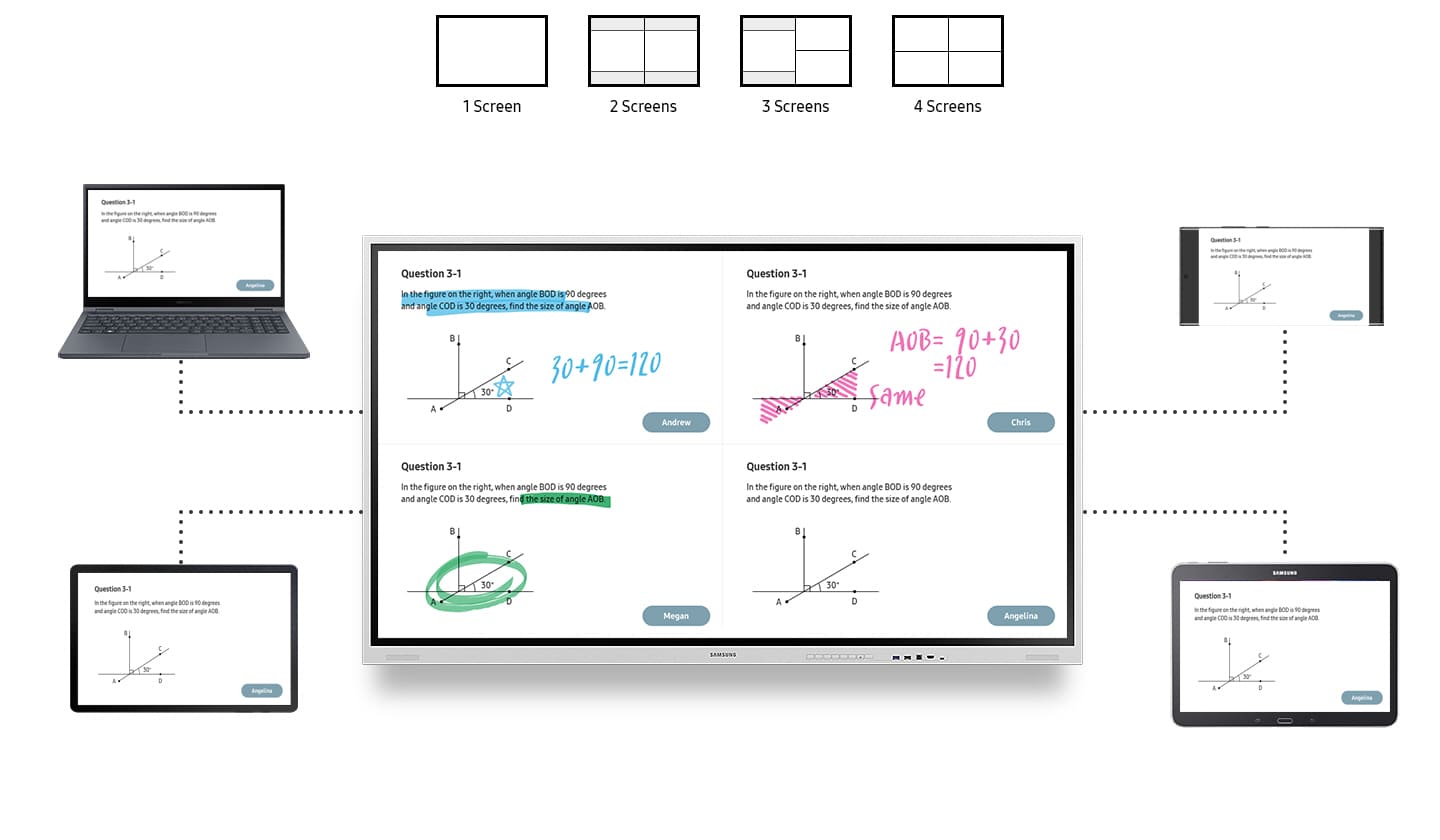
Use your favourite third-party education solutions
OPS slot
With the OPS (Open Pluggable Specification) slot*, the Flip Pro allows educators to use their third-party education solutions, enabling them to use School Information Systems (SIS), learning applications and tools.
Access everything you need from anywhere
Workspace
With the Workspace secured by Knox, Flip Pro enables easy access to remote PCs, network drives and other third-party applications such as Office 365, VMWare, Boxlight MimioConnect*. This ensures efficiency from anywhere and an uninterrupted workflow for teachers and students.
Optimise lesson planning with the embedded learning solution
Boxlight MimioConnect
Flip Pro features the MimioConnect app, an online blended learning platform that offers a rich catalogue of versatile learning content available through Workspace. Samsung's partnership with leading US education solutions delivers innovative education software directly
Easy collaboration via video conferencing
apps for video calls
Easy, seamless video conferencing is supported on the Flip Pro based on the WebRTC (Real Time Communication) API, with no additional solution compatibility required. Apps such as Google Duo are available to users with just one touch for easy and efficient collaboration.
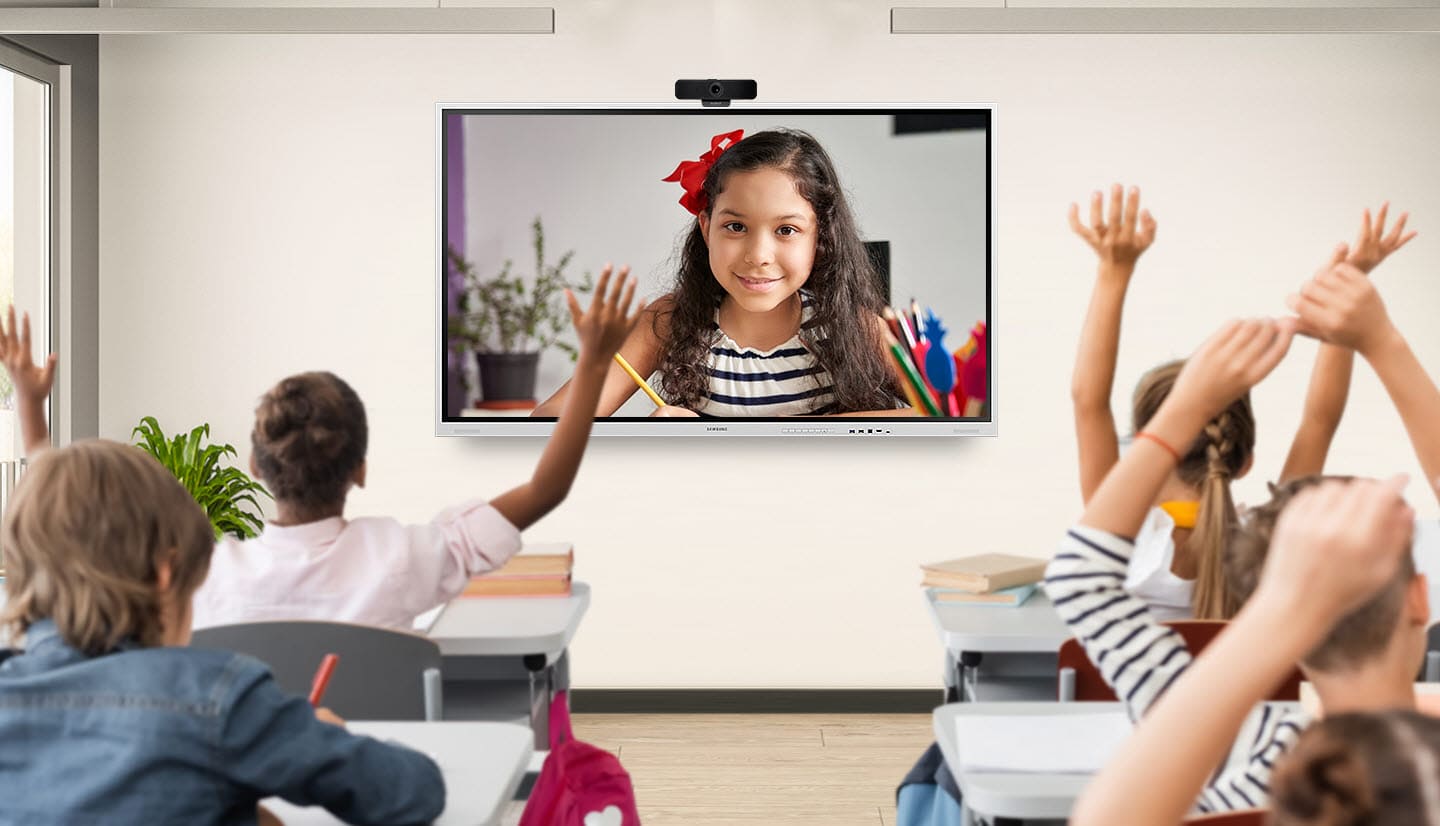
Stay in the loop with remote management solution
Remote Content Push
With Samsung's MagicINFO remote management solution, Flip Pro offers a new feature that pushes content, alerts and alarms from the school information system to the display to notify teachers and students of important updates that can be pushed directly to Flip displays in each classroom.
Carefully designed for comfortable use
Intelligent design
Flip Pro is designed specifically for education and features a handle on the back for easy transport and a control panel on the front for quick access. In addition, the sleek, light grey colour ensures that the Flip blends seamlessly into its surroundings.
Clean screen and minimised risk of damage
Protective screen technology
The Samsung Flip Pro is equipped with an integrated antimicrobial coating that prevents the growth of microorganisms. In addition, the Flip display is encased in a special shatterproof film.
Technical data
| Name | Samsung Flip Pro WM75B 75" Touch display with Intelligent wireless sharing from multiple devices with SmartView+ |
|---|---|
| Article number | 1000023338 |
| GTIN/EAN | 8806094266504 |
| Manufacturer SKU | LH75WMBWLGCXEN |
| Model name | Flip Pro WM75B |
| variant | Display |
| Brand | Samsung |
| Product Type | Touch display |
| Product Series | Samsung WM Series |
| Technology | LED Technology LED: LED is a lighting technology. With LED technology, diodes are used as illuminants and not conventional UHP lamps. The advantage of this technology is that the diodes do not use a filament and practically do not consume energy. However, LEDs have a more bluish colour range than UHP lamps, which is why the image is often perceived as somewhat colder. Colour wheel: Besides the DMD chip, the colour wheel is one of the most important criteria for image generation in DLP projectors. The colour wheel rotates constantly at extremely high speed and currently has 3, 4, 5 or, in some cases, even more colour segments. Through the colour wheel, the light from the projector lamp is alternately broken down into the primary colours red, green and blue practically without interruption. In modern projectors, the colour wheel also contains white and sometimes other colours such as cyan, magenta and yellow. With 3 segments, the colour wheel rotates at 3600 or 7200 rpm, with 7 segments at up to 14400 rpm. (4x speed). Each colour perceived by the eye in a DLP projector is therefore an extremely fast sequence of individual, differently coloured light beams until the actual processing. Because this technology sometimes does not use all the colour positions of the colour wheel for high-contrast images, or because the colours required for colour mixing are arranged far apart on the wheel, some viewers recognise the rainbow effect. This characteristic is more noticeable with slower colour wheels and slower rotation speeds than with projectors with faster and more frequently segmented colour wheels. |
| panel technology | VA |
| backlight | LED |
| Resolution | 3840 x 2160 4K UHD Resolution Resolution: The resolution of a projector is the maximum number of image points (pixels) that a projector can display based on its naturally existing technology, i.e. without conversion or cropping of the image. The native resolution is the number of pixels that a projector physically has to display the image. A projector usually interpolates a resolution when it receives an image signal with a higher resolution than the native one. If this is the case, there may be a lack of image detail or general blurring in the displayed image. If a projector receives an image signal with a lower resolution than the native, it also interpolates, it scales the image up to the native resolution, calculates corresponding additional pixels, if possible without changing the image information. The disadvantage here is that although the image is displayed larger than fed, the original individual pixels may become much more visible as they are multiplied by the conversion. 4K: 4K refers to the resolution of 3840 x 2160 or Ultra High Definition Television (UHDTV). This resolution corresponds to 4 times the resolution of Full HD. To record films with this resolution, special cameras are needed that can record at around 8 megapixels (4K). Full HD: The term Full HD is used to describe devices that can physically display or output HDTV signals in full (1920 x 1080 pixels). 1080p: 1080p is the specification of the vertical picture lines. Among other things, it refers to the resolution 1920 x 1080. The "p" in this case means full frames, so all picture lines are displayed simultaneously. 1080i: 1080i is the specification of the vertical picture lines. The "i" in this case means fields. This signal is usually displayed interpolated (e.g. by devices with a 1280 x 720 HDready resolution). The interpolation digitally adds pixels, but also offers a slight blurring. In contrast, 1080p playback uses full frames. |
| Diagonal | 75" |
| Aspect Ratio | 16:9 Aspect Ratio Format: The projected image is output in a format (aspect ratio) specified by the projector. The format is also determined by the resolution of the projector (see also the entry "Resolution"). The screen format is usually selected on the basis of the format of the beamer image. The most common formats are 4:3, 16:9 and 16:10. |
| Viewing angle - Horizontal | 178° Viewing angle - Horizontal Viewing angle: The viewing angle indicates the distance from the centre line at which the projected image is perceived as being of good quality without restrictions. As a rule, the horizontal viewing angle is specified. A good viewing angle lies within a range of 110 to 130 degrees from the centre of the picture, i.e. 55 to 65 degrees to the left and 65 to the right. If you are outside the viewing angle, the picture deteriorates disproportionately. |
| Viewing angle - Vertical | 178° Viewing angle - Vertical Viewing angle: The viewing angle indicates the distance from the centre line at which the projected image is perceived as being of good quality without restrictions. As a rule, the horizontal viewing angle is specified. A good viewing angle lies within a range of 110 to 130 degrees from the centre of the picture, i.e. 55 to 65 degrees to the left and 65 to the right. If you are outside the viewing angle, the picture deteriorates disproportionately. |
| Contrast Ratio | 4,000 :1 Contrast Ratio Contrast: The contrast reflects the gradations between the lightest and darkest point. This is determined from white to grey to black. The higher the contrast, the more precisely the individual gradations between the respective sections can be recognised. In real use, however, the contrast actually only plays a role in darkened rooms, as the light counteracts the contrast. Therefore, contrast plays a rather subordinate role in presentation devices. It should also be noted that the contrast is determined differently depending on the technology. This often results in very different values on paper. Black level: The black level indicates the lowest light value of the projection that is achieved when projecting a black image. The better the black level, the more the dark colours / black tones are emphasised in the image. |
| Screen finish | Matt |
| Number of channels | 2.0 |
| Max. Brightness | 350 cd/m² |
| run-time | 16/7 |
| Response time | 8ms |
| Refresh Rate | 75Hz |
| Support - VESA | 400 x 400 |
| Operating system | Tizen |
| Inputs | 1x Displayport , 1x Ethernet , 2x HDMI , 3x USB-A Inputs HDMI: Digital connection for the transmission of picture & sound. Necessary for high-resolution picture quality (HDTV). Since HDMI 1.4 (High Speed) suitable for transmission of 3D content in Full HD. For high-resolution picture quality in UHD, 4K or HDR, the connection via HDMI 2.0a and higher is suitable. HDMI 2.1 or higher should be used from 120Hz refresh rate in 4K. VGA: The VGA connector is a 15-pin connector for analogue image transmission. It is also called DSub15 and is often found on notebooks and PCs. Compared to the other analogue connections, it offers good picture quality. It can be screwed to the input or output device and can be adapted to YUV with a suitable configuration. DisplayPort: The DisplayPort connection is a VESA-standardised connection for the transmission of image and sound data. In addition to HDCP encryption, DPCP is also supported. Due to its compact size, the connection is most commonly used in notebooks. An extra small variant is the MiniDisplayPort, which is used especially with Apple devices. DVI: DVI (Digital Visual Interface) is an interface for the transmission of video data. Only analogue signals can be transmitted via DVi-A, only digital signals via DVI-D and both types of signals via DVI-I. USB: USB (Universal Serial Bus) is used to control and manage the projector (USB-B). With some business devices, office files and images can also be presented directly with a USB stick or a mouse can be connected via the USB input (USB-A). Toslink: The Toslink connection is an optical signal connection that works on an optical fibre basis. It is used for the digital transmission of audio signals. The optical design offers a lower susceptibility to interference from external magnetic and electrical influences. The connection is mostly used in the area of DVD / Blu-ray players and comparable devices in connection with an AV receiver, if these work with dts or Dolby Digital signals. YUV: The YUV connection, also called Y Cb/Pb Cr/Pr or component connection, is an analogue video connection with three channels (light intensity and two colour channels). Qualitatively, it is the best analogue video connection. Component cable: The YUV connector transmits analogue signals over three cables (Y=black and white UV=colours). YUV is used to transmit HDTV and is compatible with Cinch, for example. S-Video: The S-Video connection is also called S-VHS or Hosiden connection. Compared to the Cinch video connection, it works with two channels (brightness/colour). In terms of quality, it is somewhat better than the Cinch video connection, but there are also limitations. These can be explained by the susceptibility of the signal, which is reflected in picture distortions, for example. Cinch: The cinch video connection is also called composite connection. To make it easier to recognise, it is usually sheathed in yellow. Since the transmission is only via one channel, the picture quality is on a low level. D-Sub15: The VGA connector is a 15-pin connector for image transmission on an analogue basis. It is also called DSub15 and is often found on notebooks and PCs. Compared to the other analogue connectors, it offers good picture quality. It can be screwed to the input or output device and can be adapted to YUV with a suitable configuration. RS232: The RS232 interface can be used to control or manage the projector. Mini Jack: With a single-pin Mini Jack, mono audio signals can be transmitted, with a two-pin stereo audio signals and with a three-pin stereo audio signals and image data can be transmitted. Scart: Scart is a connector that can be used to transmit analogue audio and video signals. It is compatible with other analogue connections such as RCA or S-Video. ARC: The audio return channel, also called ARC or audio return channel, was introduced with HDMI version 1.4 to reduce the amount of cabling between HDMI components. The audio return channel runs via the existing HDMI cable. Therefore, an additional cable for the sound no longer needs to be connected. However, both devices must support ARC. All audio file formats that are also transmitted via the SPDIF interface can be transmitted via the audio return channel. These include Dolby Digital, Digital Theatre Sound and PCM audio. As an example, a connection between a TV (including receiver) and an AV receiver could be made via an HDMI cable. The sound from the TV is fed back via the HDMI cable. Previously, an additional digital cable (coaxial or Tos-Link) was required for the audio signals. |
| Outputs | 1x 3,5mm Jack Outputs HDMI: Digital connection for the transmission of picture & sound. Necessary for high-resolution picture quality (HDTV). Since HDMI 1.4 (High Speed) suitable for transmission of 3D content in Full HD. For high-resolution picture quality in UHD, 4K or HDR, the connection via HDMI 2.0a and higher is suitable. HDMI 2.1 or higher should be used from 120Hz refresh rate in 4K. VGA: The VGA connector is a 15-pin connector for analogue image transmission. It is also called DSub15 and is often found on notebooks and PCs. Compared to the other analogue connections, it offers good picture quality. It can be screwed to the input or output device and can be adapted to YUV with a suitable configuration. DisplayPort: The DisplayPort connection is a VESA-standardised connection for the transmission of image and sound data. In addition to HDCP encryption, DPCP is also supported. Due to its compact size, the connection is most commonly used in notebooks. An extra small variant is the MiniDisplayPort, which is used especially with Apple devices. DVI: DVI (Digital Visual Interface) is an interface for the transmission of video data. Only analogue signals can be transmitted via DVi-A, only digital signals via DVI-D and both types of signals via DVI-I. USB: USB (Universal Serial Bus) is used to control and manage the projector (USB-B). With some business devices, office files and images can also be presented directly with a USB stick or a mouse can be connected via the USB input (USB-A). Toslink: The Toslink connection is an optical signal connection that works on an optical fibre basis. It is used for the digital transmission of audio signals. The optical design offers a lower susceptibility to interference from external magnetic and electrical influences. The connection is mostly used in the area of DVD / Blu-ray players and comparable devices in connection with an AV receiver, if these work with dts or Dolby Digital signals. YUV: The YUV connection, also called Y Cb/Pb Cr/Pr or component connection, is an analogue video connection with three channels (light intensity and two colour channels). Qualitatively, it is the best analogue video connection. Component cable: The YUV connector transmits analogue signals over three cables (Y=black and white UV=colours). YUV is used to transmit HDTV and is compatible with Cinch, for example. S-Video: The S-Video connection is also called S-VHS or Hosiden connection. Compared to the Cinch video connection, it works with two channels (brightness/colour). In terms of quality, it is somewhat better than the Cinch video connection, but there are also limitations. These can be explained by the susceptibility of the signal, which is reflected in picture distortions, for example. Cinch: The cinch video connection is also called composite connection. To make it easier to recognise, it is usually sheathed in yellow. Since the transmission is only via one channel, the picture quality is on a low level. D-Sub15: The VGA connector is a 15-pin connector for image transmission on an analogue basis. It is also called DSub15 and is often found on notebooks and PCs. Compared to the other analogue connectors, it offers good picture quality. It can be screwed to the input or output device and can be adapted to YUV with a suitable configuration. RS232: The RS232 interface can be used to control or manage the projector. Mini Jack: With a single-pin Mini Jack, mono audio signals can be transmitted, with a two-pin stereo audio signals and with a three-pin stereo audio signals and image data can be transmitted. Scart: Scart is a connector that can be used to transmit analogue audio and video signals. It is compatible with other analogue connections such as RCA or S-Video. ARC: The audio return channel, also called ARC or audio return channel, was introduced with HDMI version 1.4 to reduce the amount of cabling between HDMI components. The audio return channel runs via the existing HDMI cable. Therefore, an additional cable for the sound no longer needs to be connected. However, both devices must support ARC. All audio file formats that are also transmitted via the SPDIF interface can be transmitted via the audio return channel. These include Dolby Digital, Digital Theatre Sound and PCM audio. As an example, a connection between a TV (including receiver) and an AV receiver could be made via an HDMI cable. The sound from the TV is fed back via the HDMI cable. Previously, an additional digital cable (coaxial or Tos-Link) was required for the audio signals. |
| wireless technology | Bluetooth , WiFi wireless technology WLAN: WLAN (Wireless Local Area Network) refers to a wireless network. For example, projectors or displays can be connected wirelessly to various sources (notebooks, smartphones, etc.) to realise wireless image transmission. In some cases, additional components (dongles/adapters) are required for this if a wireless connection is not directly supported. AirPlay: Apple's AirPlay technology is used for wireless transmission of content, such as music and videos, from iOS and Mac devices. These can also be receiver devices such as speakers, AV receivers and stereo systems or TVs. Streaming also works from an iOS device to a matching receiver. The protocol developed by Apple can also be licensed by other manufacturers. iProjection: With the free Epson iProjection app, projectors can be operated remotely and office content and photos can be projected. The app is compatible with current Epson business projectors and can also be used as a practical remote control. Other features of this functionality include searching for available projectors, volume control, mute, and a freeze function to freeze the current image of a presentation. The most important Office contents, such as Word, Excel, PowerPoint, Keynote and PDF files, are supported and can be played back directly from the medium. Images in JPEG and PNG format can also be presented directly. The Epson iProjection app is available for download free of charge from the Apple App Store and the google Play Store. Easy MP: A special network function from Epson. The Easy MP function allows you to present efficiently over multiple computers via an existing network. Easy MP allows you to transfer a presentation, images as well as audio data via the network and thus receive a selection from various sources in the network. |
| Power per channel | 10 W |
| Features | Integrated speaker , Touch screen |
| Product width | 172.4 cm |
| Product height | 102.63 cm |
| Product depth | 8.9 cm |
| Weight | 59.3 kg |
| Colour | White |
| EEK Spectrum | A to G |
| Delivery contents | Power cable , USB cable |
| Condition | New |
| Warranty | 24 Month |
| Warranty type | Onsite Repair Service and support information |
Manufacturer's warranty information:
Here you will find more detailed information on the different types of warranty. Please refer to our manufacturer overview for contact details and warranty conditions for the corresponding warranty claim. Statutory warranty rights are not restricted by an additional manufacturer's warranty. Our liability for defects is governed by law. Defect rights can be claimed free of charge.




